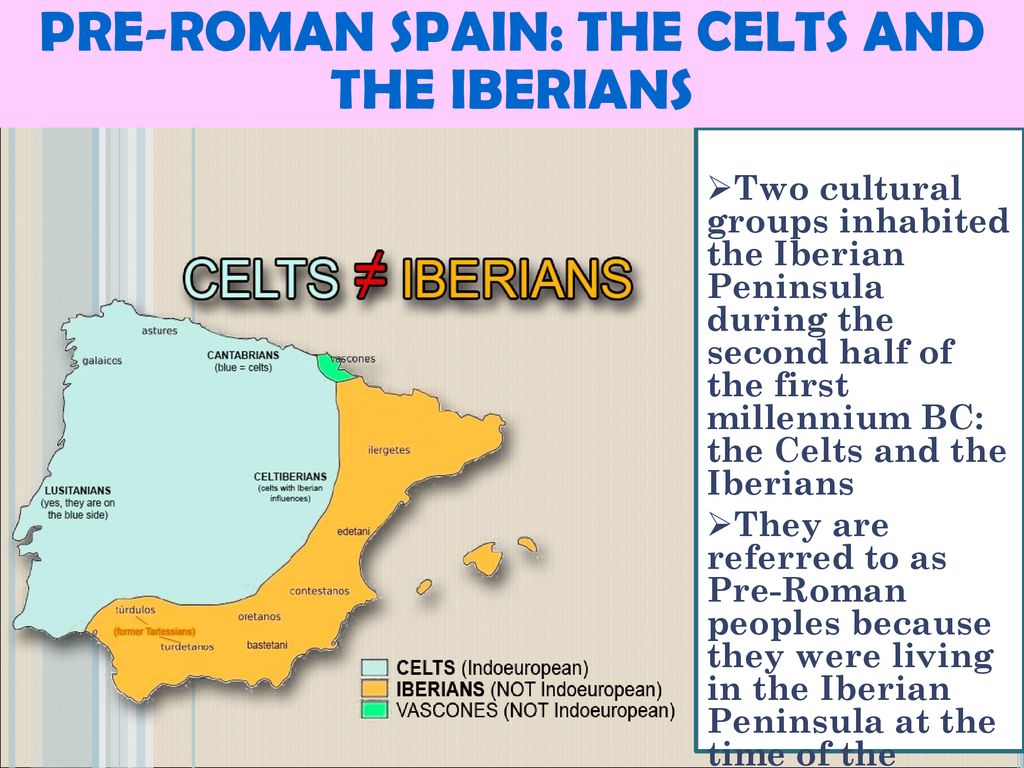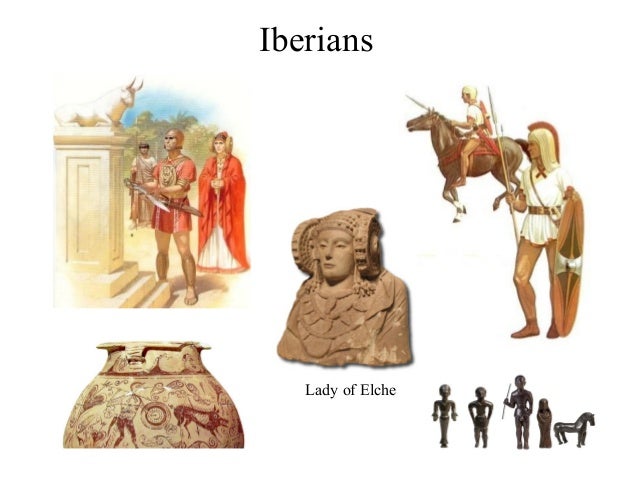WHAT AM I GOING TO LEARN?
1. Pre-Roman towns and colonizing towns
2. Roman Hispania.
3. Visigoth Hispania.
WHAT DO I HAVE TO STUDY?
●Unit from your book.
● English handouts and worksheets.
● Spanish and English vocabulary (use your glossary book and vocabulary organizer)
●Activities from your book.
● The outline you made


At the start of Ancient History, the Celts and Iberians (Celtiberians) lived on the Iberian Peninsula. From about the 10th century B.C., people from the Phoenician, Greek and Carthaginian civilisations came to the Iberian Peninsula. The Phoenicians, Greeks and Carthaginians changed how people lived on the Iberian Peninsula. They introduced new products, such as wine and olive oil; writing and the use of coins for trade.
THE IBERIANS
– They inhabited the south and east of the Iberian Peninsula.
– They were organized into tribes.
– They live in fortified settlements.
– They built rectangular houses.
– Many of them worked as farmers, craftsmen, warriors and traders.
– They had their own money and their own writing.

THE CELTS
– They inhabited the north and the centre of the Iberian Peninsula.
– They were organized into tribes.
– They live in forts. They built circular houses.
– Many of them worked as farmers and warriors.
– They made iron and bronze objects.
– They did not know how to write and did not use money.

THE GREEKS
– They came from Greece. They began 3,000 years ago in the eastern Mediterranean sea.
– They live in polis with its own governors, laws and army. The first city-states were Athens and Sparta.
– People who governed were elected by free citizens. This was the origin of democracy.
– They created colonies (Rodas, Ampurias, Sagunto and Denia on the north-eastern coast).

THE PHOENICIANS
– They came from Asia about 2,600 years ago.
– They settled on the southern coast of the Iberian Peninsula.
– They founded trading colonies (Gadir, Malaka and Sexi).
– They developed the first version of the alphabet we use today.

THE CARTHAGINIANS
– They came from the north of Africa to the Iberian Peninsula about 2,300 years ago.
– They founded new colonies (Cartago Nova and Ebusus) in the east of the peninsula and on the Balearic Islands.
– They were warrior people. They fought with the Romans.

THE ROMANS
– Rome was another important civilisation in Ancient History. It originated on the Italian Peninsula. In 218 B.C. the Romans began their conquest of the Iberian Peninsula.
– The Romans and Carthaginians were rivals. They both wanted to control the Mediterranean Sea.
– In 218 B.C. the Romans invaded the Iberian Peninsula. After many battles they defeated the Carthaginians. Now the Romans controlled the east and south of the Iberian Peninsula.
– At the beginning the Romans didn’t control all of the Iberian Peninsula. They fought different wars against the Celtiberians for almost 200 years.
– The Roman conquest ended in 19 B.C. This was when the Romans controlled all of the peninsula.
– The Romans called the Iberian Peninsula Hispania. They divided Hispania into provinces. The Romans changed how the people of the Iberian Peninsula lived. These changes are called Romanisation.
– The Romans built cities, aqueducts, roads (vías) and bridges.
– Society was divided into free people and slaves.
– They introduced Roman law ; their language, Latin; Roman schools; Roman- style sculptures, paintings and mosaics; and their religion. The Roman religion had many gods. Later on the Romans adopted Christianity and introduced it to the Iberian Peninsula.
– As well as Hispania, the Romans conquered many other lands in Europe, Africa and Asia. All of these lands together were called the Roman Empire and was ruled by the Roman emperor. Three of these emperors were born in Hispania: Trajan, Hadrian and Theodosius.
– People who lived outside the Roman Empire were called barbarians. In the 3rd century A.D., they started to invade the empire. The Romans fought against them for more than 200 years. In 476 A.D. the barbarians conquered the empire. They removed the last emperor, Romulus Augustus. This was the fall of the Roman Empire and the end of Ancient History.
– Today we can still see the remains of many Roman buildings and other structures in Spain (temples, aqueducts, theatres, baths, roads and bridges).


THE VISIGOTH KINGDOM
After the 3rd century, the Roman Empire started to lose its territories and power. It was invaded by Germanic tribes who came from the north and east of Europe. In 476, the last Roman Emperor, Rómulo Augusto, was defeated and the Empire was divided into small independent kingdoms.
The fall of the Roman Empire marks the beginning of the Middle Ages.
The Germanic tribes
In 411, taking advantage of the decline of the Roman Empire, three Germanic tribes invaded the Iberian Peninsula.
The SUEVI TRIBE settled in the northeast of the Iberian Peninsula, in the Roman province of Gallaecia
The ALANI TRIBE occupied the centre of the Iberian Peninsula, the provinces of Lusitania and Carthaginensis.
The VANDALS TRIBE settled in the south of the Iberian Peninsula, in the province of Baetica.
To defend themselves, the Romans asked for help from another Germanic tribe, the Visigoths. The Visigoths came to the Iberian Peninsula in 415. They expelled the Alani and the Vandals, but no the Suevi.

The Visigoth Kingdom
The Visigoths occupied most of the Iberian Peninsula and founded a powerful kingdom with Toledo as its capital.
In the 6th century, King Leovigildo defeated the Suevi and took control of the whole territory.
In 711, Muslims from the north of Africa invaded the Iberian Peninsula and defeated Lord King Rodrigo, the last Visigoth king.

Visigoth society
There were not many Visigoths in comparison to the Hispano-Roman population in the Iberian Peninsula. Therefore, the Visigoths adopted the Hispano-Roman culture:
-They adopted the Roman language as their official language.
-They converted to Christianity. The first Visigoth to be converted was King Recadero during the celebration of the Third Council of Toledo in 589.
-They adopted the Roman laws
The Visigoth population was formed by noblemen and peasants:
-The noblemen had a lot of power. They owned land and elected their king.
-The peasants worked the land and took care of the castle.
Visigoth culture and art
Saint Isidoro of Seville was a prominent Visigoth writer. He wrote Etymologiae, an encyclopedia in which he tried to include all the knowledge of his times.
The Visigoths built small churches made of stone with thick walls. The major contribution to architecture was the horseshoe arch.

VOCABULARY
| the Iberians the Celts inhabit fortified settlement craftsman warrior trader the Greeks Alps Ancient History aqueduct barbarians bridge the Celtiberians Christianity city city walls coin colony culture defeat Emperor fall free people Greece Greeks invade Latin law governor army polis the Phoenicians the Carthaginians civilization North Africa Numantia play product province religion remains road Roman Empire Romanisation Romans Rome school siege slave temple theatre trade tribe via writing metal mosaic | los iberos los celtas habitar asentamiento fortificado artesano guerrero comerciante los griegos Alpes Edad Antigua acueducto bárbaros puente los celtíberos cristianismo ciudad murallas de la ciudad moneda colonia culture vencer, derrotar emperador caída gente libre Grecia griegos invadir Latín ley gobernante ejército polis los fenicios los cartaginenses civilización África del Norte Numancia obra producto provincia religión restos carretera Imperio Romano romanización romanos Roma escuela asedio,acoso esclavo templo teatro comercio tribu carretera escritura metal mosaico |
